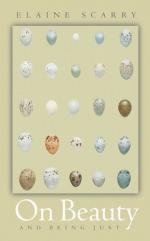
|
| Name: _________________________ | Period: ___________________ |
This test consists of 15 multiple choice questions and 5 short answer questions.
Multiple Choice Questions
1. What does Scarry say marked works created imperfectly?
(a) The need for beauty.
(b) The desire to reach perfection.
(c) The desire to attempt creation.
(d) The need for impulses.
2. Who painted "The Morning Session"?
(a) Scarry.
(b) Oscar Wilde.
(c) Picasso.
(d) Matisse.
3. When did beauty in post colonialism make a huge entrance in studies?
(a) The 1990's.
(b) The 1980's.
(c) The 1970's.
(d) The 1960's.
4. When was "The Morning Session" painted?
(a) 1924.
(b) 1934.
(c) 1894.
(d) 1984.
5. What did Proust want to stay in front of forever?
(a) A self portrait.
(b) The grave of his wife.
(c) An image of a girl serving milk.
(d) A mirror.
6. How does Wittgenstein say Leonardo Da Vinci created pure beauty?
(a) He created what he wanted.
(b) He donated his profits.
(c) He never sought for acclaim.
(d) He copied others.
7. What kind of tree did Matisse always hate?
(a) Oak.
(b) Sycamore.
(c) Palm.
(d) Maple.
8. How did Da Vinci create beauty?
(a) He painted.
(b) He was an inventor.
(c) He sketched.
(d) All of these.
9. What does Scarry say validates the existence of some things?
(a) Its affect on other things.
(b) Its reputation.
(c) Its place in history.
(d) Its beauty.
10. When was "The Painter and His Model, Studio Interior" created?
(a) 1909.
(b) 1919.
(c) 1889.
(d) 1990.
11. How does the poet who wrote about mistakes in beauty describe these mistakes?
(a) Dishonest.
(b) Unkind.
(c) Strange.
(d) Unpleasant.
12. What did Plato say really caused children?
(a) The desire of men to see themselves.
(b) The banal need for beauty.
(c) The act of beauty replicating itself.
(d) The repercussions of pride.
13. What bird did Scarry see in a tree that shocked her?
(a) A crow.
(b) An owl.
(c) A mockingbird.
(d) An eagle.
14. Where did Proust see the most beauty?
(a) In ideas.
(b) In generalities.
(c) In landscapes.
(d) In particulars.
15. How does Scarry feel about Matisse's ideas?
(a) She disagrees.
(b) She agrees with only parts of them.
(c) She is confused by them.
(d) She agrees with her.
Short Answer Questions
1. What does Scarry say is the first form of art replication?
2. What is Scarry's second conclusion about Odysseus's visit?
3. What fear did Matisse write about?
4. What does Scarry say brings about equality in society?
5. What does Scarry say is our major limitation in seeing beauty?
|
This section contains 416 words (approx. 2 pages at 300 words per page) |

|




